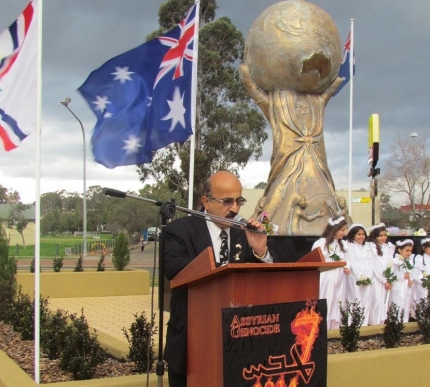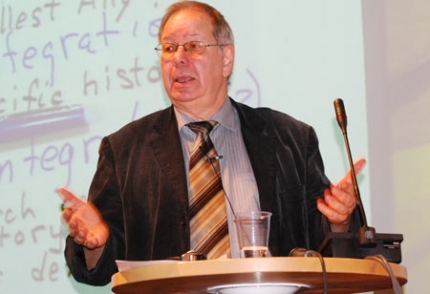Full name: Sabri Atman
Hometown: I was born in Nsibin (Tur Abdin), in southeast Turkey. [I] moved to Austria due to political reasons and [then] to Sweden five years later. I am a Swedish citizen.
Occupation: President of the Seyfo Center.
Where is your family originally from? My family and the rest of Assyrians were living in Nsibin before the Kurds and Turks came to the region.
For those that do not know, what is the Seyfo Center? The Seyfo Center is a research center that tries to raise awareness [about] the Assyrian Genocide. The Center is based in Sweden, but there are also branches in Germany, the Netherlands, Belgium, Switzerland and in the United States. We [also] have a pretty good cooperation in Canada with ACSSU (Assyrian Chaldean Syriac Student Union).
Many people ask what is the meaning of the term “Seyfo”? It is connected with the memorialization of [past] events. The Jews were burned and killed alive in the concentration camps. Today, we refer to those unthinkable events as the “Holocaust,” which means to burn to death. The genocide in Rwanda has become known as the Machete Genocide, for obvious reasons. The Armenian Genocide is known as Meds Yeghern, which simply means great calamity. In the Assyrian Genocide, our people were killed with the sword. Therefore, we call it “Seyfo” in western dialect or “Saypa” in eastern dialect. In addition to that, Seyfo means also extermination in our language.
What exactly does the Seyfo Center do? In our attempt to raise awareness for the Assyrian Genocide, we have several fields. Some of the activities Seyfo Center is committed to include [having a] pool of sources and provide research assistance to scholars, writers, journalists, filmmakers and government agencies. We document the Assyrian Genocide by collecting oral history and endorsing written evidence. We present the Assyrian Genocide in parliaments and government bodies. We educate non-Assyrians in political and academic forums. We participate in activism on behalf of the Assyrian Genocide. We publish books, reports, brochures, and other means of media. We also do lobbying.
Where are some places in the world where Seyfo is recognized? On the 19th of December 2007, the International Association of Genocide Scholars made a resolution and recognized the Assyrian Genocide. On May 13, 2009, a press conference took place in the Swedish Parliament. A Kurdish intellectual named Berzan Boti apologized for the Genocide of 1915 and as an act of restitution, handed back his property to its rightful owners — the Assyrians. The deeds of his property were then transferred to the Seyfo Center.
On March 10th 2010, the Swedish Parliament recognized the Assyrian Genocide. Thanks to the Assyrian Universal Alliance (AUA) and the struggle demonstrated by the Assyrians in Australia, a monument has been erected on Aug. 7, 2010, for the memorial of the Assyrian victims during the First World War and the Simele Massacre. May 1, 2013, [the] Australian Parliament of New South Wales (NSW) recognized the Assyrian and the Greek Genocide.
On Wednesday, April 25, 2012, the Assyrian Genocide monument was unveiled in capital, city of Armenia in Yerevan. On Saturday, the 27th of April 2013, the third Assyrian Genocide monument was unveiled in France. On Aug. 4, 2013, the Assyrian Genocide monument was unveiled in Belgium. On October 19, 2014, an Assyrian Genocide monument was unveiled in Athens. On March 24th 2015, the Republic of Armenia recognized the Assyrian genocide.
Pope Francis recognized the Armenian, Assyrian and Greek Genocide and on April 10, 2015, the Dutch Parliament recognized Assyrian, Greek and Armenian Genocide. On April 22, 2015, the Austrian Parliament recognized the Assyrian Genocide. On June 18, 2016, an Assyrian Genocide monument was unveiled in Locarno, Switzerland. I am sure that in the very near future we will have more monuments erected around the world and here in the United States too. The number of countries who recognize the Assyrian Genocide will increase dramatically.
Why are some countries, like Turkey or the U.S., reluctant to accept the Assyrian-Armenian-Greek Genocides? This year is the 101th anniversary of the Assyrian and Armenian Genocide. Turkey denies this fact and spends almost 300 million USD a year to accomplish that. It is a strong country with a large population and international allies; they have their scholars, politicians, activists and money. In spite of that, I am very glad to tell you that we made a great achievement in the last 10 years regarding the Assyrian Genocide. First of all, the word Seyfo now is more known on both national and international levels. With this I mean the awareness is higher than before.
Are there any books, or films, you would recommend if someone wishes to learn more about Seyfo? I would recommend David Gaunt’s Massacres, Resistance, Protectors: Muslim-Christian Relations in Eastern Anatolia during World War I. And theBiography of RaphaelKhan.
How many Assyrians died during Seyfo? There are numbers that say as low as 250,000 to as high as 750,000. The Assyrian delegations presented two numbers on the Assyrian loses during the 1914-1918 genocide. The first number was 250,000 and the second number 275,000. I don’t know much about the 750,000 [number]. However, if we start from the 15th century, I believe the number can be much higher than 750,000.
What were some of the methods to which Assyrians were killed during Seyfo? Why were Assyrians targeted during the Genocide? Assyrians were mostly killed by sword. The main reason for the genocide was that the Ottoman Turks wanted to homogenize Turkey.
It has been said that many Muslims, Turks and Kurds, helped save Assyrians during the Genocide. Is this true? We should do more research about the involvement of the Kurdish population in the state-sponsored violence against Assyrians. The Assyrians were one of the three Christian groups (along [with] Armenians and Greeks) victimized during what is know as the Armenian Genocide. As all genocides happened, they were also some Turks and Kurds [who] wanted to help the Christians during the genocide of 1915.
How did you feel when U.S. Secretary of State, John Kerry, formally called the acts by ISIS against Iraq’s minorities “genocide”? It was important and I was happy that the U. S. Secretary of State, John Kerry, formally called the acts by ISIS against Iraq’s minorities’ genocide. But I was not happy that he missed the mention of the Assyrians. We don’t want to be called “only” Christians. We were Assyrians before we became Christians and we should keep in mind that Assyrians are secular people and not all want to consider themselves Christians. There are non-believing Assyrians as well.
It has been said that the Yazidis have had 72 massacres in their history. Is there a number you know of that correlates to how many massacres Assyrians have endured throughout the centuries? Yazidis have had 74 massacres. For the Assyrians the most known massacres are Bedirhan massacre in 1843, Abdulhamid massacres in 1894-1896, 1909 and 1914-1918, 1922, Simele Massacre 1933 and the on-going genocide in Iraq and Syria.
Do you have a favorite word in Assyrian/Syriac? What is it? Shlomo/Shlama, Sabro, and Athro/Athra.
Favorite Assyrian food? My favorite food is bushala, but the one that is made by Ninva Younan from Los Angeles.
Any final thoughts you’d like to share? Seyfo is part of our history and it is significant to have knowledge about our past. The best way to prevent future genocide and persecution is to condemn past genocides. As Assyrians, we are obliged to raise awareness about what happened to us during the First World War.
Seyfo Center tries to involve our people in our activities. In our modern history, we suffered from many genocide and persecution. Examples such as the 1843 massacre, 1894-1896 Abdulhamit’s massacres in the Ottoman Empire, 1909 Massacre in Adana, the Genocide of 1915, the Simele massacre in 1933 and the ongoing genocide and persecutions in Iraq and in Syria. [These all] make our people tired and depressed. There is a deep feeling that people don’t want to talk about it and remember. However, regardless of if we talk or not; these things are a reality and we can’t ignore our reality. This entire thing that we go through and are facing is our history — we should face it. It is about our identity. It is about [whether] to be or not to be!
Portions of this interview have been edited.
By Ramsen Shamon



